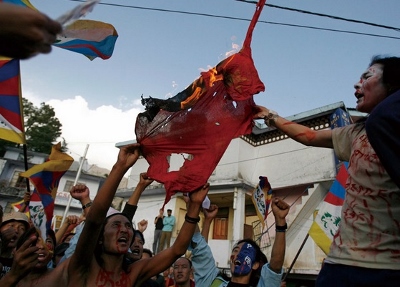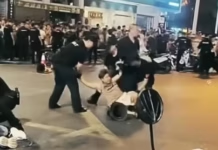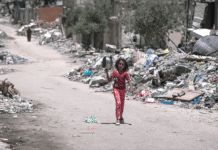Brutal crackdown by Beijing regime meets muted reaction from foreign governments
With the Olympic Games less than five months away, the Chinese dictatorship seems to have opted for a massive and swift crushing of the protests in Tibet, counting only on muted protests from foreign capitalist powers that are economically more and more dependent on China. Predictably the US, EU and other governments have issued standard expressions of ‘concern’ but have also made clear the Tibetan protests and ensuing repression will not affect relations with Beijing in the slightest. In the region, governments in India and Himalayan neighbour Nepal, where the Maoist former guerrillas have four government ministers, have forcibly broken up demonstrations of solidarity with the Tibetan protesters. In Lhasa, the latest reports indicate sweeping house-to-house searches for alleged ‘rioters’ in the city’s Tibetan quarters, with official media calling the ongoing operation a ‘war’ against splittist (i.e pro-independence) forces. A state of undeclared martial law exists in Lhasa and other Tibetan areas, with unconfirmed reports of eight Tibetan protesters killed in the Aba region of Sichuan province on Sunday.
Rather than restoring ‘stability’, a new round of state terror – maybe calculated to ‘pacify’ Tibet before the Olympic Games get underway in August – will only worsen an already explosive situation. Tibetan youth, many from the countryside where three quarters of the Tibetan population still live, lead an increasingly desperate existence in Lhasa and other cities where they move to find work, only to meet discrimination, brutal police harassment and cutthroat competition for jobs from growing numbers of Han Chinese settlers. Despite a spectacular construction boom, and an economy that grew by 13.8% last year, the TAR has one of the most extreme wealth gaps in China, with Tibetans at the very bottom. Incomes in rural Tibet are only a third of the average for China as a whole. While wealthy Han Chinese drive around in expensive foreign cars in cities like Lhasa, many Tibetan youth are forced to turn to crime or prostitution. The influx of Han traders and small businesses in recent years, which accelerated once the new railway was opened two years ago, has only further marginalised the Tibetan poor. While officially Lhasa’s population is still 78% ethnic Tibetan, when migrant workers from other provinces and PLA soldiers are factored in, there is already a 60% Han dominance in the Tibetan capital.
Led by the “Dalai clique”?
A detailed picture of what is happening now is extremely hard to put together because of the regime’s media and information crackdown. Foreign journalists have been expelled from the area. Hong Kong and Macau TV crews have also been summarily deported with their film footage confiscated. The Hong Kong Association of Journalists has lodged a protest about the treatment of its members by the Chinese authorities, many of whom were held for hours before being released. The iron ring of censorship extends to the internet. Not only are foreign sites like YouTube blocked now for the duration of the Tibetan troubles, even the UK Guardian and other news sites are temporarily suffering the same fate that chinaworker.info experiences on a regular basis. On domestic Chinese blogs and web forums, any mention of Tibet is quickly expunged by the censors. In the cyberworld, Tibet has already ceased to exist!
The Beijing regime is involved in a propaganda war to sell its version of events to Chinese public opinion and the world at large. But clearly the expulsion of all independent witnesses – even tourists are now being turned back – shows the regime’s version of events cannot be believed. State media has been full of lurid tales of vicious attacks on Han civilians. The regime desperately wants to drive a wedge between Tibetan protesters and other oppressed groups – workers fighting factory closures, anti-pollution protesters, peasants resisting land seizures – whose struggles provoke a similar violent response from the Chinese state. But if the official version of events was truthful then the authorities would insure foreign journalists and eyewitnesses were there to corroborate this. Clearly they have something to hide. As the saying goes, “truth is the first casualty of war”.
Beijing is blaming the “Dalai clique” for inciting the protests, a reference to the Tibetan Buddhist spiritual leader and his exile government in India. This is also clearly not the case. The Dalai Lama stands for a conciliatory approach towards Beijing, hoping for a form of Hong Kong-style greater autonomy within China, rather than independence. But this strategy, which he calls the “middle way”, is increasingly rejected by more radical layers of the Tibetan population especially the youth. Just as Israel’s occupation and repression in Palestine has undermined the leadership of the more ‘moderate’ i.e. pro-capitalist and pro-West Palestinian organisations such as Fatah, the current explosion of Tibetan anger is a sign of the weakening political authority of the Dalai Lama and his government-in-exile. These exile “leaders” have based their strategy on winning support from foreign governments, the UN, and other capitalist and imperialist agencies in order to exert pressure on Beijing. This has been an abysmal failure in a world where government and business leaders increasingly compete with each other to kowtow to the Chinese dictatorship in return for economic gains.
The splits within the Tibetan movement have now burst into the open. A spokesman for the Tibetan Youth Congress said the Dalai Lama was “out of step” with the mood of Tibetans for refusing to call for an Olympic boycott and for renouncing violence. A Tibetan schoolteacher in Dharamsala, India (the seat of the exile government), told AFP, “at the moment, Dalai Lama is out of the picture. It’s a Tibetan people’s movement.” Some layers of Tibetan youth look approvingly to the guerrilla struggle in Nepal, while in fact it was a mass urban protest movement and general strike in April 2006, rather than the rural-based armed struggle led by Nepal’s Maoists, that ended the rule of the absolute monarchy.
This is the background to the latest upsurge of protest. It is born of the continued daily humiliations under Han domination, a feeling of betrayal by the outside world and a sense of abandonment by the exile leaders. More radical sections of the Tibetan movement, hoping to get global attention before the Olympics, set their sights on 10 March, the anniversary of the defeated 1959 uprising against Chinese rule. Exiled Tibetans in northern India organised two marches with the expressed aim of crossing the border and going on to Lhasa. These demonstrations were turned back by Indian security forces. This however resonated with youth inside Tibet, including young lamas (monks), who took to the streets in what were by all accounts non-violent protest marches to begin with.
Propaganda war
The protests span out of control on Friday, with large scale rioting, looting, burning of shops and reports of indiscriminate attacks on Han civilians, on fire crews and even ethnic Tibetans who came in harm’s way. The regime-controlled media has of course given enormous prominence to interviews with hospitalised victims of these attacks. In a movement without organisation or leadership, it is entirely possible that a layer of lumpenised Tibetan youth took part in racist attacks on Han civilians. Socialists and politically conscious workers do not condone such actions. But we would also point out it is a matter of common knowledge that the state forces sent agent provocateurs into the demonstrations and probably also used hired thugs to sow confusion and chaos, discredit the protest movement, and thereby give a pretext for a ruthless crackdown. This is exactly the same pattern as in Burma last year, where Chinese military advisors coached the Burmese junta on how to split and crush the mass movement. It is a common feature of protest movements in China that police vehicles and government buildings are attacked and sometimes burned as anger boils over and there are no democratic organisations to channel the struggle into more disciplined and effective means of protest such as the general strike.
The Chinese regime wants to blame the violence on the demonstrators and portray the Tibetan protests as a racist anti-Chinese pogrom in order to whip up nationalist indignation across China, to drown out any criticism of its repressive policies in Tibet and give it a blank cheque for a further crackdown. An editorial in the regime-controlled Tibet Daily called this “a life and death struggle”, conjuring up military associations of “war” against splittism (i.e. demands for independence). Beijing’s media ‘spin’ is also designed to neutralise international criticism: “Is there any democratic country ruled by law which can put up with such violence?” said Qiangba Puncog, the chairman of Tibet’s regional government.
But the brutal methods being used by the security forces in the Tibetan regions today are exactly the same methods used against Han Chinese workers and farmers whenever they fight for their rights. For this reason, workers and socialists everywhere should demand an end to the repression in Tibet, the immediate lifting of martial law and withdrawal of paramilitary police and army units. The tragedy of the situation in Tibet, as elsewhere in China, is the complete lack of independent working class organisations – trade unions and political parties – that could organise multi-ethnic neighbourhood defence groups to protect homes, buildings and lives, while also initiating joint struggle by Han Chinese and Tibetan workers and poor against the evils that face both communities: spiralling food prices, lack of affordable housing, lack of jobs for young people, collapsing public services.
The way forward
Among Tibetan youth there is a sense of urgency – ‘something must be done’ – even if they are not clear exactly what should be done. Socialists defend the right of the Tibetan people to decide their own future, up to and including the right to independence, with full national rights and guarantees for the Han Chinese minority and other ethnic groups inside Tibet. But to succeed the movement in Tibet must fully draw the lessons not just of their own history, but also of other national liberation and anti-despotic struggles, especially in the era of globalised capitalism and imperialism. A look around the region shows that national independence on a capitalist basis can in no way solve the problems of the impoverished masses. Take the examples of nominally ‘independent’ Bhutan and Nepal across the border. These states are dominated by outside powers, wracked by poverty, and ruled by racist undemocratic elites. Yet even this type of ‘independence’ is not remotely posed for Tibet as long as the present pro-capitalist dictatorship rules China. Even the Dalai Lama’s mooted option of a more genuine autonomy similar to that enjoyed by Hong Kong, is ruled out on the basis of the existing state power in China. The Beijing regime tolerates a wide degree of autonomy for Hong Kong for particular economic and historical reasons, but it rightly fears that similar concessions to Tibet would open a Pandora’s Box of demands for autonomy from other provinces, threatening a territorial unravelling of China. For reasons of their own prestige and power, Beijing’s authoriatrian rulers cannot be seen to be rewarding Tibetan insubordination.
To go forward against such a powerful state, and one which moreover is supported in its policies towards Tibet by the capitalists around the world, the Tibetan masses must therefore link their struggle for basic democratic rights and an end to Chinese military occupation to the unfolding struggle of the super-exploited Chinese working class. The Tibetan youth especially must support and build links with the struggle of the Chinese workers and youth, who are fighting the same oppressor, and seek fundamentally the same freedoms: an end to one-party rule and police terror, freedom of assembly, freedom of speech and religious worship, the right to organise, and the abolition of class exploitation through the socialisation of industry under democratic workers’ control and management. Genuine democratic socialism has nothing in common with the bureaucratic one-party dictatorships of Mao or Stalin, let alone today’s neo-liberal ‘communists’ who rule China and the TAR. By linking up with the oppressed masses of the Himalayan region and india also, the Tibetan people’s struggle – as a socialist and anti-imperialist struggle – could inspire a continental movement to settle accounts with the rotten and corrupt system of capitalism and to establish international socialism.




